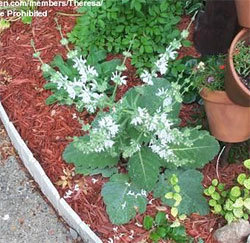





As you can tell from the picture, this is not your typical sage, that's for sure. Say hello to Silver Sage, otherwise known as Salvia argentea.
(Editor's Note: This article was originally published on October 4, 2008. Your comments are welcome, but please be aware that authors of previously published articles may not be able to promptly respond to new questions or comments.)
After several years of rough treatment, my old, lone silver sage finally succumbed recently. I am still grieving. It probably got tired of the frequent transplanting, the collie lifting his leg over it, and the slugs chomping on it. Suffice it to say, I've already purchased another one and have promised myself my new addition will receive better care.
I kept my Silver Sage in a container for several years and, while it did ok, it never got to a flowering size. Actually, that could be why the plant lasted so long. Many gardeners don't allow their silver sage to send up a flower stalk as it takes an incredible amount of energy out of the plant. Silver Sage is often listed in catalogs as a "short-lived perennial" or even a biennial for this very reason.
So forget about the flowers: it's the foliage of Salvia argentea that's so fantastic anyway. The large basal clump of silver, fuzzy leaves with beautiful rounded, scalloped edges will brighten up a dark spot, cause heads to turn and hands to outstretch. No one can resist petting the furry coat on Silver Sage's huge leaves. Gardeners who like Lamb's Ear but want even more of a silvery accent should make a mad dash for this plant.
As far as companion planting, nothing beats the look of silver plants cuddled up to those with dark foliage; the contrast is striking and will also add depth to the appearance of your landscape. Try nestling silver sage in with some of the annual purple-leafed sweet potato vines or ornamental peppers during the summer months. Or place it at the feet of a dark-colored shrub such as a ‘Summer Wine' purple ninebark or a ‘Black Lace' (aka ‘Eva') elderberry. For a cool container arrangement, picture the ‘wow factor' that would result from pairing a Silver Sage with a spiky dark phormium or cordyline!
You will usually find Silver Sage offered as a plant, but seeds are also available from various online stores. Check the Dave's Garden PlantScout for Salvia argentea seed sources. Grow them as you would any other sage by starting seeds in early spring in peat pellets, or direct sowing in the garden once the soil has adequately warmed.
 Here are the basic stats and Tips for Salvia Argentea:
Here are the basic stats and Tips for Salvia Argentea:
Here in North Texas, my dearly departed silver sage seemed to do best when it had rich, slightly moist, well-draining soil and morning sun with afternoon shade. Cooler climates can probably give it full sun with no problems. Silver sage is pretty tough in that it is somewhat drought-tolerant and deer-resistant...but please, don't abuse yours like I did mine. This plant deserves better.
Dave's Garden photo credits:
Top right photo by member Happenstance
Left photo by member Theresa
Copyright © www.100flowers.win Botanic Garden All Rights Reserved